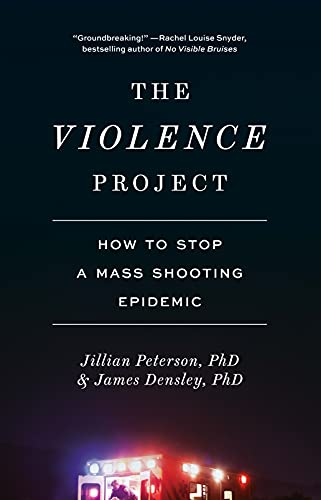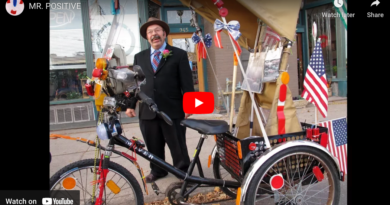The Violence Project illuminates culture of mass shootings
By Margaret Kinney
Our country is in the grip of a mass shootings epidemic. It is unique to our country and to our times. The USA experiences mass shootings at a level that is unique to our country and to our times. As citizens, we shake our heads in sadness and anger, and sometimes we point fingers. As citizens, we shake our heads in sadness and anger, and sometimes we point fingers. Two St. Paul professionals have gone to great lengths to explain why neither despair nor finger-pointing will solve this complex social and political public health issue.
The Violence Project written by Jillian Peterson, Ph.D., a professor of criminology and criminal justice at Hamline University, and James Densley, Ph.D., a professor of criminal justice at Metropolitan State University, is a handbook for every one of us. Together the authors run a nonpartisan and nonprofit research center called the Violence Project, located on East Seventh Street in St. Paul.
With mass shootings and death counts on the rise, the authors point out early in the book that the perpetrators of mass violence are not the other; they are always one of us. This means it can become our opportunity to intervene when we sense that something is not right with a person we know. The book gives numerous ways that ordinary people can help prevent shootings in many cases.
Shooters are often students in the schools, and/or members of the communities where the violence has taken place. (A mass shooting is defined in this article as when one non-military person shoots more than three people in one setting. It includes domestic violence.)
The authors call students born since 2000 members of “the lockdown generation,” having grown up with school shootings being somewhat normalized. With comprehensive research and interviews, the authors have yhshooters before they ever pick up a gun.” Peterson and Densley understand from working in the justice system for many years, that “you can’t prevent violence from occurring unless you fully understand its roots.”
There are four factors (identified by the authors) that show up in the lives of the mass shooters: -childhood trauma; -an identifiable crisis point; -a script to follow and someone to blame; and -opportunity.
(Recent federal gun legislation may decrease the availability of some automatic firearms to some potential shooters.)
The book acknowledges the complex social, familial, and cultural factors that are present in the shaping of a person who perpetrates mass killings with guns. There is not one simple cause or solution. Historian Randolph Ross is quoted in his book American Homicide: ”When we lose faith in our government and political leaders when we lack a sense of kinship with others, … it affects the confidence with which we go about our lives. Small disagreements, indignities, and disappointments that we might otherwise brush off may enrage us….. and in some cases give way to violence.”
According to the authors, early childhood intervention from trauma is necessary to stop the epidemic of desire for violence toward oneself and others. Early detection and intervention is crucial and can largely resolve the impact that trauma has.
In the book, we learn that The National Alliance on Mental Illness has begun to expand its school-based mental health services because they have been shown to be successful in offering assessment, treatment, case management and individual therapies. Current federal legislation being hammered out in Congress could have a vital impact on resources available for mental health services in schools. It is suggested that schools and doctors could adopt automatic universal mental health screening of all children, thereby neutralizing mental health care stigmas. The book quotes educational psychologist Katie Eklund: “We do screening for vision and hearing. And for academics. Why don’t we do the same for social-emotional and mental health?”
Many schools have implemented social and emotional learning, which involves helping children develop their skills in communication, problem-solving, conflict management, and emotional regulation. The adults in the lives of children play a crucial role. “According to the Harvard Center for the developing child, the single most common factor for children who are resilient in the face of trauma is a stable, committed relationship with a supportive adult in their lives,” the authors write
Also found in the book are in-depth descriptors as to what it means to be in a crisis, (factor number two in the lives of mass
shooters) and how citizens, family members, and friends can recognize and intervene when someone is in crisis mode. “We have a tendency to think crisis intervention can be done only in a counselor’s office, but the right person to step in often has a previous relationship with the person in crisis. In one averted school shooting we studied, it was the janitor who stepped in to de-escalate the student,” the authors write
The book is not a dry or detached statistical manual. It addresses and supports gun control but does not focus on any one simplistic or political solution. What makes the book compelling is the passion for nonviolence displayed by the authors and the number of included personal accounts relayed by the shooters and the people who knew them.
The book offers us hope in turning around our epidemic of mass hopelessness and despair, which, on an individual and collective level, often ends in violence. “After every mass shooting, the media like to fixate on motive, but in reality, the pathway to mass violence is long and winding,” the authors write.
The authors write, “As individuals, as institutions, and as a country, we can break the cycle of violence, and this book offers a world map for how because the power to change lives and the course of history in our schools, workplaces, and communities lies with us.”
The Violence Project organization offers training videos and programs for people who are interested in holistic violence
prevention. Their website gives immediate references to interviews with the cofounders, at theviolenceproject.org.
Margaret Kinney, MA in Human Development and retired LADC, is a West End artist and writer. She serves on the board of The Community Reporter.




